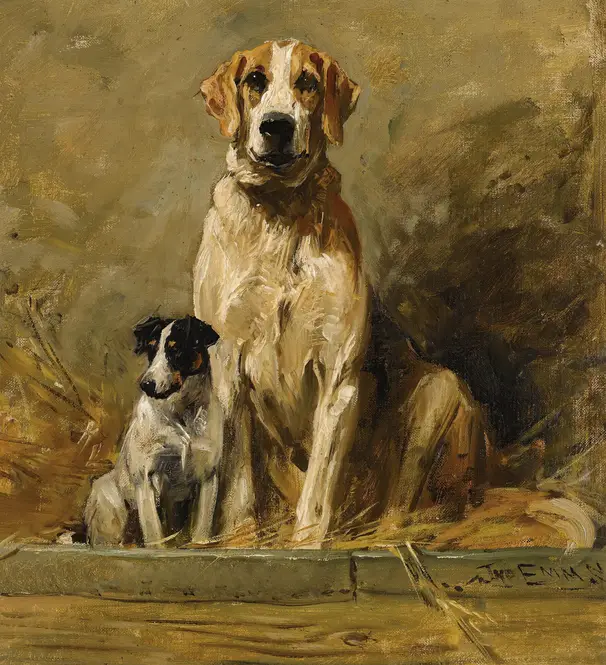John Emms
John Emms (1843–1912), English, A master of animal portraiture, particularly dogs and horses, this Victorian-era painter captured the vitality and character of his subjects with remarkable precision. His work blended the sporting tradition of British art with a keen observational eye, often infusing his compositions with warmth and narrative charm. Though less celebrated than some contemporaries, his paintings were sought after by aristocrats and dog enthusiasts alike, reflecting the era’s obsession with pedigree and sporting culture.
Trained under the influential Sir Edwin Landseer, he absorbed techniques that emphasized texture—whether the gloss of a hound’s coat or the muscular tension of a hunter mid-chase. Unlike Landseer’s sentimentalism, however, his approach was more direct, even unsentimental at times, focusing on the animal’s innate presence rather than anthropomorphism. Foxhounds, terriers, and spaniels recur in his work, each rendered with individualized personality, their poses suggesting movement or alertness.
Financial struggles late in life overshadowed his career, yet his legacy endures among collectors of sporting art. Today, his works are prized for their technical rigor and unpretentious honesty—a quiet counterpoint to the grandiosity of 19th-century academic painting. The occasional flicker of humor (a terrier’s mischievous glance, a stallion’s impatient snort) hints at an artist who, beneath the formal demands of his patrons, genuinely delighted in his subjects.
Trained under the influential Sir Edwin Landseer, he absorbed techniques that emphasized texture—whether the gloss of a hound’s coat or the muscular tension of a hunter mid-chase. Unlike Landseer’s sentimentalism, however, his approach was more direct, even unsentimental at times, focusing on the animal’s innate presence rather than anthropomorphism. Foxhounds, terriers, and spaniels recur in his work, each rendered with individualized personality, their poses suggesting movement or alertness.
Financial struggles late in life overshadowed his career, yet his legacy endures among collectors of sporting art. Today, his works are prized for their technical rigor and unpretentious honesty—a quiet counterpoint to the grandiosity of 19th-century academic painting. The occasional flicker of humor (a terrier’s mischievous glance, a stallion’s impatient snort) hints at an artist who, beneath the formal demands of his patrons, genuinely delighted in his subjects.
-

Hound And Terrier In A Kennel
John Emms (English, 1843–1912)A vibrant portrayal of two dogs in a kennel, their contrasting personalities brought to life through dynamic brushwork and playful details.
